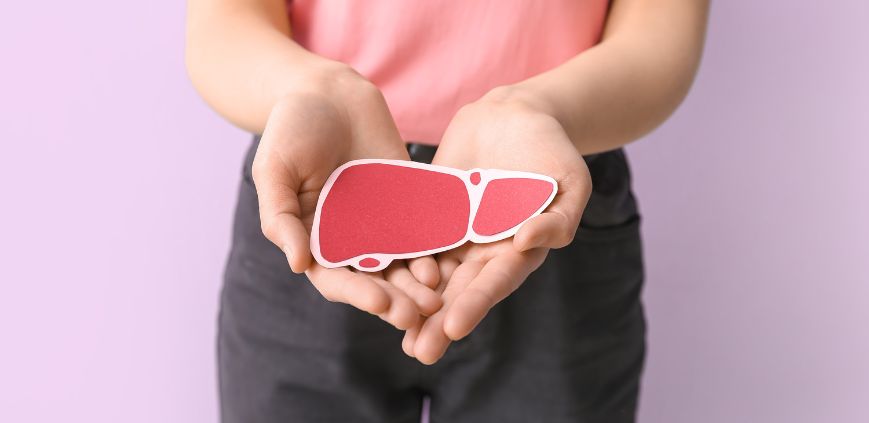Empowering Awareness
Non-alcoholic steatohepatitis (NASH) is a silent liver disease that resembles alcoholic liver disease but occurs in people who drink little to no alcohol. Understanding the signs of liver damage and the dietary and lifestyle factors that can contribute to NASH is crucial for early detection and treatment. In this article, we will discuss the signs of liver damage, foods and drinks that can harm the liver, what NASH is, its causes and symptoms. We will also look at some available treatment options for NASH, including Rezdiffra, which is used to treat adults with NASH who also have liver scarring.
Signs of Liver Damage
1. Jaundice
This is when the skin and whites of the eyes turn yellow, indicating a buildup of bilirubin, a byproduct of old red blood cells the liver normally breaks down and removes.
2. Abdominal Pain and Swelling
The liver pain is typically felt in the upper right abdomen and can be a sign of inflammation or enlargement of the liver.
3. Itchy Skin
Skin itching can occur due to the buildup of bile products in the body when the liver is not functioning properly.
4. Dark Urine
This can be caused by the presence of bilirubin in the urine.
5. Pale Bowel Movements
This can occur if the liver does not release enough bile into the stool.
6. Constant Fatigue
A feeling of continual tiredness can be due to the overall decrease in liver function.
7. Nausea and Vomiting
This general distress might be related to the buildup of toxins that the liver is unable to filter out.
8. Loss of Appetite
Can be caused by imbalances in the digestive process due to liver damage.
9. Bruising Easily
Because the liver produces clotting factors, damage to the liver can result in easier bruising and bleeding.
Foods and Drinks That Damage the Liver
Certain foods and drinks can contribute to liver damage and exacerbate conditions like NASH.
1. Alcohol
Excessive alcohol consumption is one of the most well-known causes of liver damage.
2. Soda
High in fructose and empty calories, soda can lead to obesity and the development of liver damage.
3. Fruit Juice
Often perceived as healthy, many fruit juices are also high in fructose and should be consumed in moderation.
4. Sugary Foods
Excess sugar can lead to fat accumulation in the liver, especially in the form of fructose.
5. Fried Foods
High in calories and trans fats, fried foods can contribute to weight gain and obesity, placing extra stress on the liver.
6. Salty Foods
Consuming too much salt can lead to water retention and swelling, making it harder for the liver to function.
7. White Bread, Rice and Pasta
Refined carbohydrates can lead to spikes in blood sugar and contribute to liver fat storage.
8. Red Meat
High in saturated fat, red meat can increase the risk of liver damage if consumed in excess.
What is NASH?
Non-alcoholic steatohepatitis (NASH) is a progressive form of non-alcoholic fatty liver disease (NAFLD). It is marked by the presence of inflammation and liver cell damage, along with fat in the liver. Over time, this inflammation and damage can lead to scarring, known as fibrosis, which can progress to cirrhosis, liver failure or liver cancer.
Causes and Symptoms
The exact cause of NASH is not entirely understood, but it is associated with several risk factors, including:
- Obesity.
- Insulin resistance.
- High blood sugar (indicating prediabetes or type 2 diabetes).
- High levels of fats, particularly triglycerides in the blood.
NASH often has no symptoms until the liver damage is extensive. When they do appear, symptoms may include:
- Pain in the upper right abdomen.
- Weakness and fatigue.
- Loss of appetite.
- Unexplained weight loss.
- Jaundice (indicated by yellowing of the skin and eyes).
- Swelling in extremities (edema).
- Ascites (abdominal fluid buildup).
- Easy bruising and bleeding.
Treatment Options for NASH
Until recently, there was no specific medication approved for NASH, but there are several ways the disease can be managed and its progression slowed. Here are some common management therapies for NASH.
- Weight loss: Losing weight can reduce fat in the liver, inflammation and fibrosis. A weight loss of three to five percent can improve steatosis, while a loss of 10% or more can improve inflammation and fibrosis.
- Managing blood sugar: Keeping blood sugar levels under control, especially for patients with type 2 diabetes or prediabetes, can help manage NASH.
- Diet: Emphasizing vegetables, fruits, whole grains and healthy fats, while reducing intake of refined carbs, sugars and saturated fats, can help manage NASH.
- Exercise: Regular physical activity can help reduce liver fat and improve overall health.
- Rezdiffra: Rezdiffra (resmetirom) is used to treat adults with NASH who also have moderate to severe liver fibrosis. It functions as a partial agonist of thyroid hormone receptor-beta (THR-beta), the primary thyroid hormone receptor in the liver. Its mechanism involves stimulating this receptor, leading to decreased triglyceride levels within the liver.
NASH Unraveled
NASH is a significant health concern with potentially serious consequences if left untreated. Early recognition of liver damage signs, proper dietary habits, lifestyle changes and appropriate medical treatment are key to managing and preventing the progression of the disease. Individuals must engage with healthcare providers for routine screenings, especially if they present risk factors for liver diseases.
